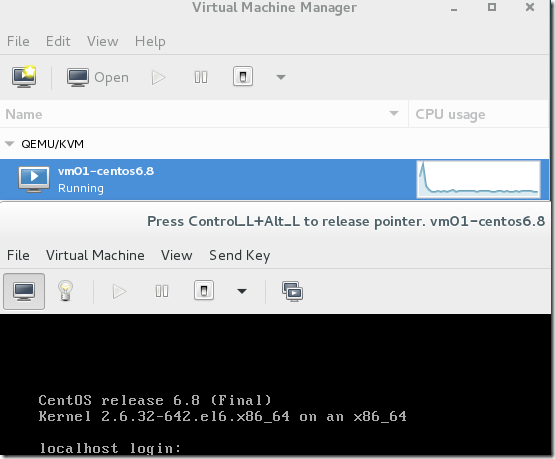003.KVM virtual machine deployment-CentOS6.8
An experiment description##
It is recommended to use the qcow2 disk format for the KVM virtual machine of CentOS 7. This experiment installs the CentOS 6.8 64 virtual machine in the KVM.
Second command deployment process##
2.1 Upload mirror
Use winscp to upload to /data/iso/
2.2 Format Disk###
1 virt-install --network bridge=br0,model=virtio --name=vm01-centos6.8--ram=1024--vcpus=2--disk path=/data/images/vm01-centos6.8.img,size=20,bus=virtio --cdrom /data/iso/CentOS-6.8-x86_64-bin-DVD1.iso --vnc --vncport=5902--vnclisten=0.0.0.0--noautoconsole --accelerate
Parameter Description:
-
- name: Specify the name of the virtual machine
-
- ram: allocated memory size.
-
- vcpus: allocates the number of CPU cores, the maximum is the same as the number of CPU cores of the physical machine.
-
- disk: Specify the virtual machine image, size specifies the allocation size unit as G.
-
- network: Network type. The default is used here. Generally, bridge should be used.
-
- accelerate: accelerate
-
- cdrom: Specify the installation image iso.
-
- vnc: Enable VNC remote management, generally the installation system must be enabled.
-
- vncport: Specify the VNC monitoring port, the default port is 5900, and the port cannot be repeated.
-
- vnclisten: Specify the VNC binding IP, the default binding is 127.0.0.1, here is changed to 0.0.0.0.
-
- os-type=linux,windows: common operating system types.
-
- os-variant=
win7:MicrosoftWindows7
vista:MicrosoftWindowsVista
winxp64:MicrosoftWindowsXP(x86_64)
winxp:MicrosoftWindowsXP
win2k8:MicrosoftWindowsServer2008
win2k3:MicrosoftWindowsServer2003
freebsd8:FreeBSD8.x
generic:Generic
debiansqueeze:DebianSqueeze
debianlenny:DebianLenny
fedora16:Fedora16
fedora15:Fedora15
fedora14:Fedora14
mes5.1:MandrivaEnterpriseServer5.1andlater
mandriva2010:MandrivaLinux2010andlater
rhel6:RedHatEnterpriseLinux6
rhel5.4:RedHatEnterpriseLinux5.4orlater
rhel4:RedHatEnterpriseLinux4
sles11:SuseLinuxEnterpriseServer11
sles10:SuseLinuxEnterpriseServer
ubuntuoneiric:Ubuntu11.10(OneiricOcelot)
ubuntunatty:Ubuntu11.04(NattyNarwhal)
ubuntumaverick:Ubuntu10.10(MaverickMeerkat)
ubuntulucid:Ubuntu10.04(LucidLynx)
ubuntuhardy:Ubuntu8.04LTS(HardyHeron)
2.3 kvm virtual machine installation###
1[ root@kvm-host qemu]# virt-manager

The installation process is slightly
Three login virtual machine##
3.1 Start the virtual machine###
1[ root@kvm-host ~]# virsh list --all
2 Id Name State
3- - - - - - - - - - - - - - - - - - - - - - - - - - - - - - - - - - - - - - - - - - - - - - - - - - - - 4- vm01-centos6.8 shut off
5[ root@kvm-host ~]# virsh start vm01-centos6.8
3.1 Virtual Machine Manager login###
In the graphical interface, use virt-manager to log in from the graphical interface.

3.2 Command line login###
1[ root@kvm-host ~]# virsh console vm01-centos6.8
Four other attention##
4.1 kvm virtual machine network###
It is possible that the kvm virtual machine has only the lo network card after logging in, but not eth0.

Need to be executed in the kvm virtual machine-
1 vi /etc/sysconfig/network-scripts/ifcfg-eth0
2 DEVICE=eth0
3 HWADDR=52:54:00:cd:4e:34 #It needs to be always in the xml configuration file of kvm and is globally unique.
4 ONBOOT=yes #boot
5 NM_CONTROLLED=yes
6 BOOTPROTO=dhcp
7 Tip: If DHCP exists in the LAN, it can be turned on. If not, it can be configured with a static IP in the same network segment as the host.
8 # ifconfig eth0 up
9 # dhclient eth0 #Turn on the eth0 network card.
4.2 Cannot connect to kvm virtual machine via console###

If there is a stuck, you need to modify the relevant files in the kmv virtual machine. The kvm virtual machine of CentOS7 can be solved in the following ways——
1[ root@kvm-host ~]# grubby --update-kernel=ALL --args="console=ttyS0"2 CentOS6 can be solved in the following ways-
3[ root@kvm-host ~]# echo ssyS0 >>/etc/securetty #Host/etc/securetty add ttyS0
4[ root@kvm-host ~]# echo "S0:12345:respawn:/sbin/agetty/ ttyS0 115200">>/etc/inittab
5[ root@kvm-host ~]# vi /etc/grub.conf
6 kernel /vmlinuz-2.6.32-431.el6.x86_64 ro root=/dev/mapper/VolGroup-lv_root …… rhgb quiet console=ttyS0 #Finally add console=ttyS0

Recommended Posts